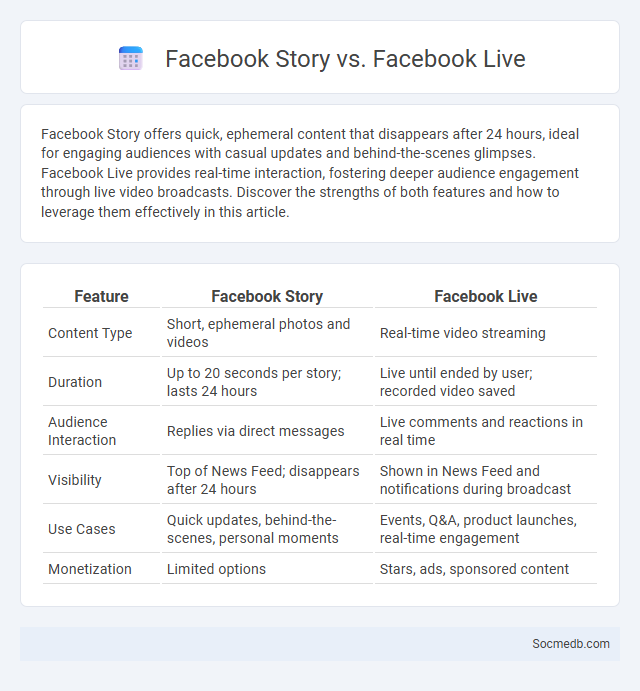
Photo illustration: Facebook Story vs Facebook Live
Facebook Story offers quick, ephemeral content that disappears after 24 hours, ideal for engaging audiences with casual updates and behind-the-scenes glimpses. Facebook Live provides real-time interaction, fostering deeper audience engagement through live video broadcasts. Discover the strengths of both features and how to leverage them effectively in this article.
Table of Comparison
| Feature | Facebook Story | Facebook Live |
|---|---|---|
| Content Type | Short, ephemeral photos and videos | Real-time video streaming |
| Duration | Up to 20 seconds per story; lasts 24 hours | Live until ended by user; recorded video saved |
| Audience Interaction | Replies via direct messages | Live comments and reactions in real time |
| Visibility | Top of News Feed; disappears after 24 hours | Shown in News Feed and notifications during broadcast |
| Use Cases | Quick updates, behind-the-scenes, personal moments | Events, Q&A, product launches, real-time engagement |
| Monetization | Limited options | Stars, ads, sponsored content |
Introduction to Facebook Story, Facebook Live, and Meta Story
Facebook Stories offer a dynamic way to share ephemeral photos and videos that disappear after 24 hours, promoting real-time engagement. Facebook Live enables users to broadcast live video content, fostering direct interaction through comments and reactions during the stream. Meta Story integrates immersive augmented reality features and interactive formats, enhancing user-generated content and expanding storytelling possibilities across the Facebook ecosystem.
Key Differences Between Facebook Story and Facebook Live
Facebook Story offers ephemeral content that lasts 24 hours, designed for short, engaging updates using photos or videos with creative filters and stickers. Facebook Live enables real-time video broadcasting to followers, fostering immediate interaction through comments and reactions. Stories prioritize quick, casual sharing, while Live emphasizes authentic, interactive experiences with viewers.
What is Facebook Story? Features and Uses
Facebook Story is a feature allowing users to share photos, videos, and text that disappear after 24 hours, fostering real-time, casual engagement. It includes interactive elements such as stickers, polls, filters, and mentions, enhancing user interaction and content personalization. Marketers leverage Facebook Stories to boost brand visibility, drive engagement with ephemeral content, and connect authentically with their audience.
Understanding Facebook Live: Real-Time Engagement
Facebook Live enables real-time video streaming, allowing users to broadcast directly to their audience and interact instantly through comments and reactions. This platform enhances engagement by fostering authentic connections, as viewers can ask questions and receive immediate responses. Utilizing Facebook Live effectively boosts brand visibility and builds a loyal community by delivering timely, interactive content.
Comparing Story Formats: Facebook vs Instagram vs Messenger
Facebook stories offer interactive stickers, polls, and longer video uploads, appealing to users seeking more engagement tools. Instagram stories prioritize visual creativity with extensive filters, music integration, and seamless shopping tags, enhancing influencer and brand reach. Messenger stories focus on direct communication with friends through quick shares and multimedia messaging, emphasizing personal connections over public visibility.
Content Types Best Suited for Facebook Story vs Live vs Story
Facebook Stories thrive on short, engaging visual content like behind-the-scenes snippets, quick updates, and interactive polls that capture immediate attention within 24 hours. Facebook Live is ideal for real-time interaction, allowing you to connect deeply with your audience through Q&A sessions, product launches, or live events that foster authentic engagement and community building. Your content strategy will benefit by matching the format to your goals: use Stories for fleeting, engaging moments and Live videos for immersive, interactive experiences.
Audience Interaction: Polls, Comments, and Reactions
Audience interaction on social media significantly increases through polls, comments, and reactions, fostering active user engagement and real-time feedback. Polls provide valuable insights into audience preferences, while comments enable direct conversations and community building around content. Reactions, including likes, shares, and emojis, offer quick emotional responses that boost content visibility and platform algorithms.
Privacy Settings and Visibility Options
Social media platforms offer a range of privacy settings and visibility options that allow users to control who can see their posts, profile information, and activity. Customizable features include audience selection such as public, friends-only, or private, as well as options to block or restrict specific users. Understanding and regularly updating these settings enhances online security and protects personal data from unauthorized access.
Analytics and Performance Metrics Comparison
Social media analytics tools like Google Analytics, Sprout Social, and Hootsuite offer comprehensive performance metrics including engagement rates, click-through rates, and audience demographics to measure campaign effectiveness. Comparing these platforms reveals that Google Analytics excels in tracking website traffic and conversion data, Sprout Social provides detailed social listening and competitor analysis, while Hootsuite delivers robust scheduling and cross-platform monitoring features. Businesses can optimize their social media strategies by leveraging these insights to enhance content reach, user interaction, and ROI.
Choosing the Right Format for Your Social Media Strategy
Selecting the right format for your social media strategy depends on audience preferences, platform algorithms, and content goals. Video content, such as reels and live streams, typically garners higher engagement on platforms like Instagram and TikTok, while infographics and articles perform well on LinkedIn and Facebook. Tailoring formats to the unique strengths of each social channel maximizes reach, enhances user interaction, and drives conversions.
 socmedb.com
socmedb.com